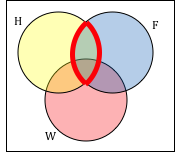Learning Outcomes
- Perform the operations of union, intersection, complement, and difference on sets using proper notation.
- Be able to draw and interpret Venn diagrams of set relations and operations.
Commonly, sets interact. For example, you and a new roommate decide to have a house party, and you both invite your circle of friends. At this party, two sets are being combined, though it might turn out that there are some friends that were in both sets.
Math vocabulary and notation
It takes repetition and practice to obtain new vocabulary in a language that is new to you. Math is no different in many respects than learning a new language, with all its vocabulary, syntax, and spelling conventions. The symbols in this section may be completely unfamiliar to you. If so, you’ll need to spend time with them, employing flashcards and writing them out by hand in context.
Give yourself time to learn and appreciate the language of mathematics!
Union, Intersection, and Complement
The union of two sets contains all the elements contained in either set (or both sets). The union is notated A ⋃ B. More formally, x ∊ A ⋃ B if x ∈ A or x ∈ B (or both)
The intersection of two sets contains only the elements that are in both sets. The intersection is notated A ⋂ B. More formally, x ∈ A ⋂ B if x ∈ A and x ∈ B.
The complement of a set A contains everything that is not in the set A. The complement is notated A’, or Ac, or sometimes ~A.
A universal set is a set that contains all the elements we are interested in. This would have to be defined by the context.
A complement is relative to the universal set, so Ac contains all the elements in the universal set that are not in A.
a new use for a superscript
Notice in the descriptions of the notation introduced above that the complement of a set is denoted [latex]A^{c}[/latex]. This superscript is not an exponent. It is a decoration that denotes the complement of a set.
Here is a short video with some examples finding the union, intersection, and complements of some sets. Click Here – Union, Intersection, and Complement – Video
Example
- If we were discussing searching for books, the universal set might be all the books in the library.
- If we were grouping your Facebook friends, the universal set would be all your Facebook friends.
- If you were working with sets of numbers, the universal set might be all whole numbers, all integers, or all real numbers
Example
Suppose the universal set is U = all whole numbers from 1 to 9. If A = {1, 2, 4}, then Ac= complement of set A = {3, 5, 6, 7, 8, 9}.
Try It
intersection and union symbols
The union [latex]\cup[/latex] and intersection [latex]\cap[/latex] symbols look a little like letters in the alphabet. In fact, that’s a trick for remembering them.
The union symbol looks like a capital U, for union.
The intersection symbol looks a little like a big lower-case n, for in-tersect
Example
Consider the sets:
A = {red, green, blue}
B = {red, yellow, orange}
C = {red, orange, yellow, green, blue, purple}
Find the following:
- Find A ⋃ B
- Find A ⋂ B
- Find Ac⋂ C
Try It
As we saw earlier with the expression Ac ⋂ C, set operations can be grouped together. Grouping symbols can be used like they are with arithmetic – to force an order of operations.
Example
Suppose H = {cat, dog, rabbit, mouse}, F = {dog, cow, duck, pig, rabbit}, and W = {duck, rabbit, deer, frog, mouse}
- Find (H ⋂ F) ⋃ W
- Find H ⋂ (F ⋃ W)
- Find (H ⋂ F)c ⋂ W
Venn Diagrams
To visualize the interaction of sets, John Venn in 1880 thought to use overlapping circles, building on a similar idea used by Leonhard Euler in the 18th century. These illustrations are now called Venn Diagrams.
Venn Diagram
A Venn diagram represents each set by a circle, usually drawn inside of a containing box representing the universal set. Overlapping areas indicate elements common to both sets.
Basic Venn diagrams can illustrate the interaction of two or three sets.
Here is a video showing the set operations (union, intersection, and complement) that we have learned represented in a Venn diagram.
Example
Create Venn diagrams to illustrate A ⋃ B, A ⋂ B, and Ac ⋂ B
A ⋃ B contains all elements in either set.
Example
Use a Venn diagram to illustrate (H ⋂ F)c ⋂ W
Candela Citations
- Revision and Adaptation. Provided by: Lumen Learning. License: Public Domain: No Known Copyright
- Question ID 132343. Provided by: Lumen Learning. License: CC BY: Attribution. License Terms: IMathAS Community License CC-BY + GPL
- Math in Society. Authored by: Open Textbook Store, Transition Math Project, and the Open Course Library. Located at: http://www.opentextbookstore.com/mathinsociety/. License: CC BY-SA: Attribution-ShareAlike
- Sets: drawing a Venn diagram. Authored by: David Lippman. Located at: https://youtu.be/CPeeOUldZ6M?list=PL7138FAEC01D6F3F3. License: CC BY: Attribution
- Sets: drawing a Venn diagram. Authored by: David Lippman. Located at: https://youtu.be/CPeeOUldZ6M. License: CC BY: Attribution
- Question ID 6699. Authored by: Morales,Lawrence. License: CC BY: Attribution. License Terms: IMathAS Community License CC-BY + GPL
- Question ID 125855. Authored by: Bohart, Jenifer. License: CC BY: Attribution. License Terms: IMathAS Community License CC-BY + GPL





